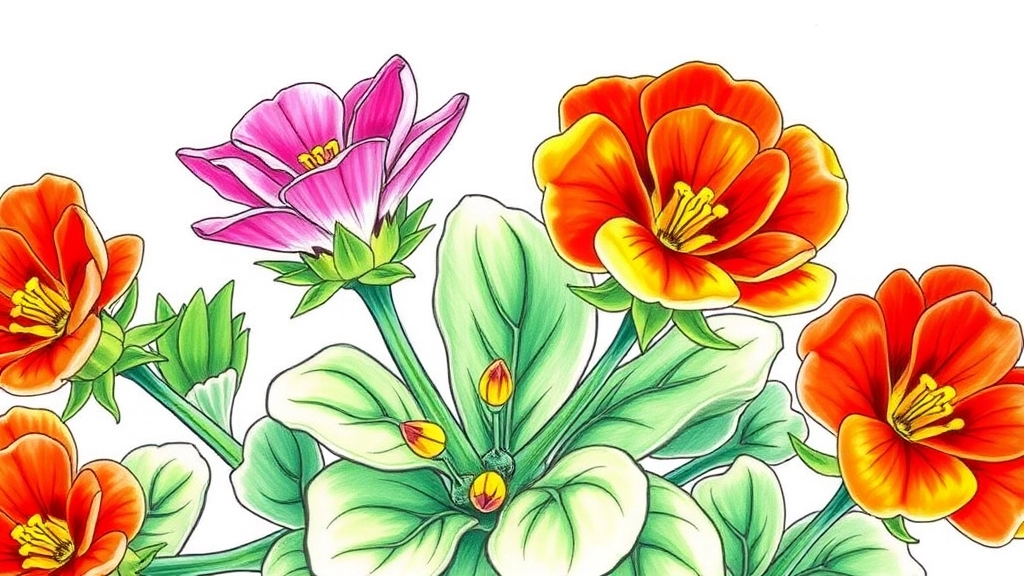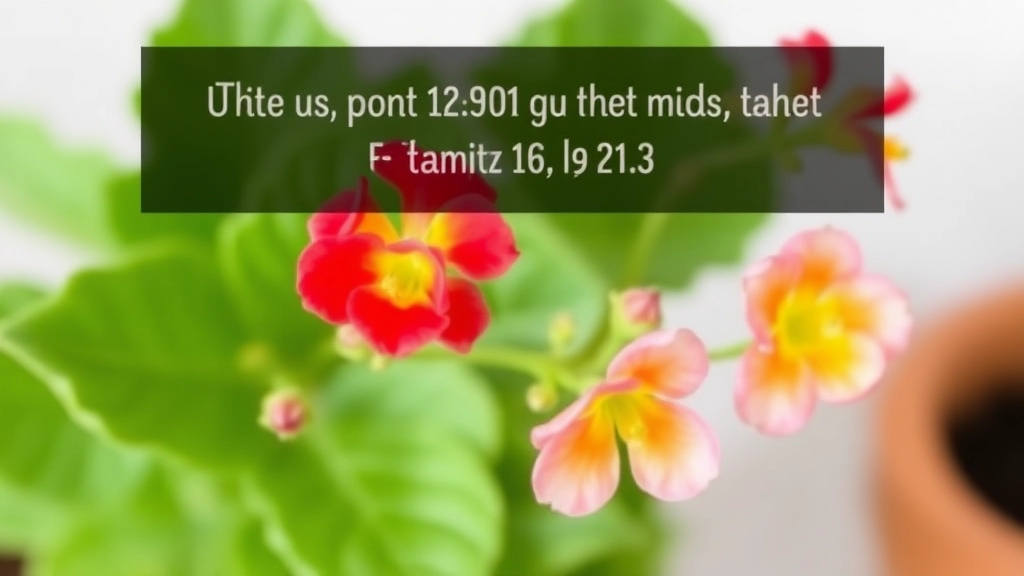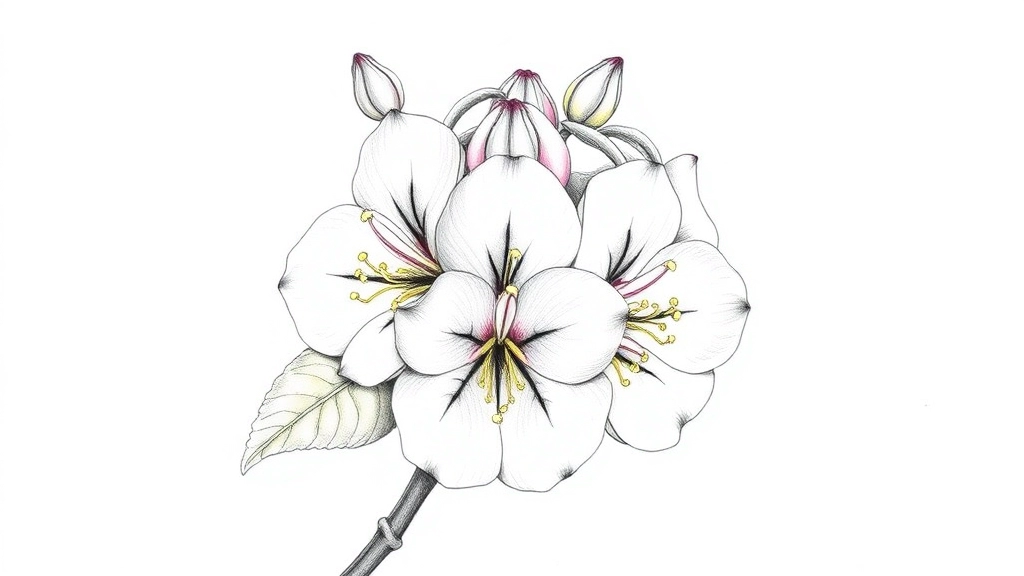Creating a Stunning Kalanchoe Flower Drawing
Looking to create a stunning Kalanchoe flower drawing? You’re in the right place! Whether you’re sketching for a creative project or just for fun, capturing the beauty of this unique plant can be incredibly rewarding. I’ll guide you through the essentials to get started, from the key features to highlight to the best tools and materials. Let’s dive into the art of drawing Kalanchoe flowers and make your botanical illustrations stand out.
Step-by-Step Guide to Sketching a Kalanchoe Flower
First, let’s focus on how to sketch a Kalanchoe flower step-by-step. Begin by observing the plant’s distinct features: its thick, fleshy leaves and vibrant clusters of tiny flowers. Use light, gentle strokes to outline these elements, gradually adding details as you go. Remember, practice makes perfect, so don’t be afraid to make mistakes. With the right techniques and a bit of patience, you’ll soon create a beautiful Kalanchoe flower drawing that’s perfect for any project.
How to Sketch a Kalanchoe Flower: Step-by-Step Guide
Have you ever found yourself staring at a beautiful Kalanchoe flower, wondering how to capture its unique charm on paper? You’re not alone. Many budding artists struggle with translating the intricate details of this stunning plant into a sketch.
In this step-by-step guide, I will walk you through the process of sketching a Kalanchoe flower, ensuring you capture its beauty effectively.
Step 1: Gather Your Materials
Before diving into the sketching process, ensure you have the following tools handy:
- Pencil: A good quality sketching pencil will allow for easy adjustments.
- Eraser: For correcting any mistakes.
- Paper: Use smooth, thick paper suitable for pencil sketches.
- Reference Image: Have a clear image of a Kalanchoe flower to guide you. For inspiration, you might want to explore the top flowering Kalanchoe species and their unique characteristics.
Step 2: Start with Basic Shapes
Begin by lightly sketching the basic shapes that form the Kalanchoe flower:
- Draw a circle for the flower’s centre.
- Add oval shapes around the centre for the petals.
- Use simple lines to outline the leaves and stems.
Step 3: Refine the Outline
Once you have the basic shapes, refine your outline:
- Add details to the petals, making them slightly wavy to mimic their natural form.
- Define the leaves with jagged edges and veins. For more detailed guidance on leaf structures, check out our Kalanchoe Blossfeldiana leaf care tips.
Step 4: Add Texture and Shading
To give your drawing depth:
- Use short, light strokes to create texture on the petals.
- Shade areas that would naturally be darker, such as the base of the petals and the centre of the flower.
Step 5: Final Touches
Finally, review your sketch:
- Erase any unnecessary lines.
- Darken the outlines for a polished look.
- Consider adding colour if desired, using coloured pencils or watercolours.
Key Features of the Kalanchoe Flower to Highlight in Drawings

When you’re getting ready to sketch a Kalanchoe flower, you might wonder, “What should I focus on to make it truly pop?”
First off, let’s talk about the unique shape of the petals. Kalanchoe flowers often have a bell-like structure that can be quite captivating.
- Petal Arrangement: Look for clusters of flowers that bloom together. They often form a tight, rounded shape.
- Texture: The petals can be smooth or slightly waxy. Capturing this texture adds depth to your drawing.
- Colour Variations: Kalanchoe flowers come in a rainbow of colours—reds, pinks, yellows, and whites. Make sure to highlight these vibrant hues in your sketches.
- Leaf Structure: Don’t forget the leaves! They’re usually thick and fleshy, with a slightly serrated edge. This contrast with the delicate flowers can make your drawing more dynamic.
As you sketch, think about how these features interact. The way the petals overlap or how the leaves frame the flowers can tell a story.
When embarking on the journey of sketching a Kalanchoe flower, having the right tools and materials is essential for achieving the desired results. You may wonder what specific items you need to create stunning botanical illustrations.
### Essential Tools
– **Pencils:**
– Use a range of pencils, from hard (H) for fine lines to soft (B) for shading.
– A mechanical pencil can also be a great choice for precision.
– **Paper:**
– Choose high-quality, acid-free paper to prevent deterioration over time.
– Watercolour paper is ideal if you plan to add colour.
– **Erasers:**
– A kneaded eraser is excellent for lifting graphite without damaging the paper.
– A precision eraser can help with fine details.
– **Inking Pens:**
– Fine liners in various sizes will help you outline your drawings.
– Waterproof ink is recommended if you plan to use watercolour.
– **Paints:**
– Watercolours or coloured pencils are popular choices for adding colour.
– Consider using gouache for a more opaque finish.
### Additional Materials
– **Ruler:** Useful for creating straight lines and measuring proportions.
– **Blending Stumps:** Great for smoothing out pencil shading.
– **Reference Images:** Gather high-quality photographs or real [Kalanchoe flowers](https://planthq.org/comprehensive-kalanchoe-species-list-for-gardeners/) to study their structure and details.
Having these tools at your disposal will make the process smoother and more enjoyable. For specific care tips on the plants you might be drawing, check out this [complete care guide for Kalanchoe tubiflora](https://planthq.org/complete-care-guide-for-kalanchoe-tubiflora-mother-of-millions/).
Common Mistakes When Drawing Kalanchoe Flowers

When embarking on the journey of sketching Kalanchoe flowers, it’s easy to fall into certain traps that can hinder your artistic expression. Understanding these common mistakes will not only enhance your drawing skills but also deepen your appreciation for this beautiful plant.
1. Ignoring Proportions
One of the biggest pitfalls is neglecting the proportions of the flower. Kalanchoe blooms can appear deceptively simple, but getting the size and relationship of petals right is crucial.
- Tip: Use a light pencil to sketch basic shapes before adding details. This will help you maintain accurate proportions.
2. Overlooking Texture
Kalanchoe petals have a unique texture that can be overlooked in haste. Failing to capture this can make your drawing appear flat.
- Tip: Observe the surface closely. Use varying pencil strokes to replicate the texture, focusing on highlights and shadows.
3. Lack of Detail in Leaves
The leaves of the Kalanchoe are just as important as the flowers themselves. Many artists focus solely on the blooms, neglecting the intricate details of the foliage.
- Tip: Spend time studying the leaves. Their shape and texture can add depth to your overall composition.
4. Rushing the Colouring Process
When it comes to adding colour, many artists rush through this phase, leading to an unbalanced look.
- Tip: Layer your colours gradually. Start with lighter shades and build up to darker tones for a more realistic effect.
5. Failing to Capture the Flower’s Shape
Kalanchoe flowers have a distinct shape that varies from species to species. A common mistake is not paying attention to the specific form of the flower you are drawing.
- Tip: Reference multiple images of Kalanchoe flowers to understand their variations and unique characteristics.
When it comes to illustrating Kalanchoe flowers, the art style you choose can significantly impact the final outcome.
**What style should you pick?**
– **Realism**: This style focuses on capturing the Kalanchoe’s intricate details and vibrant colours. It’s perfect for botanical illustrations where accuracy is key.
– **Watercolour**: The soft, flowing nature of watercolour can beautifully represent the delicate petals of Kalanchoe. This technique allows for a subtle blending of colours, evoking a sense of lightness.
– **Line Art**: For a minimalist approach, line art simplifies the Kalanchoe into clean, defined shapes. This style can be striking and modern, making it ideal for contemporary design projects.
– **Impressionism**: If you prefer a more expressive style, impressionism offers a way to capture the essence of the Kalanchoe with bold brush strokes and vibrant palettes. This can convey the flower’s character rather than its exact likeness.
– **Digital Illustration**: Embracing technology can lead to unique interpretations of Kalanchoe flowers. Digital tools allow for experimentation with colour, texture, and layering, resulting in innovative designs.
**Why does this matter?**
Choosing the right art style not only enhances your illustration but also aligns with your intended message and audience. For instance, if you’re aiming to create a detailed botanical piece, you might want to explore the [realism style](https://planthq.org/kalanchoe-flapjack-paddle-plant-care-guide/). On the other hand, if you’re looking for something more modern and minimalist, [line art](https://planthq.org/kalanchoe-pumila-silver-gray-care-guide-tips/) could be the perfect fit.
Using Kalanchoe flower drawings in design projects can be a game-changer!
These vibrant blooms bring a splash of colour and a touch of nature that can elevate any design. Whether you’re working on invitations, home decor, or digital graphics, incorporating Kalanchoe illustrations can really set your work apart.
Here’s how to use Kalanchoe flower drawings effectively:
– **Branding**: Use Kalanchoe designs in your logo or packaging. Their unique shape and colour can create a memorable brand identity.
– **Stationery**: Think about using these flowers in greeting cards, notebooks, or calendars. They add a fresh, botanical feel that’s perfect for any occasion.
– **Website Design**: Integrate Kalanchoe illustrations into your website. They can serve as beautiful backgrounds or accent images that enhance the overall aesthetic.
– **Social Media**: Share your Kalanchoe drawings on platforms like Instagram or Pinterest. They can attract attention and engage your audience, making your posts stand out.
– **Textiles**: Consider printing Kalanchoe designs on fabric. They can be used for cushions, curtains, or even clothing, bringing a natural vibe into your space.
Why Kalanchoe?
– **Symbolism**: Kalanchoe flowers often represent love and joy, making them perfect for heartfelt projects.
– **Versatility**: Their vibrant colours and unique shapes mean they can fit into a variety of design styles, from modern to vintage.
Tips for Success:
– **Keep it Consistent**: Make sure the style of your Kalanchoe drawings matches the overall theme of your project.
– **Experiment with Colours**: Don’t shy away from mixing different hues. Kalanchoes come in a range of colours, so play around to find what works best for you.
– **Combine with Other Elements**: Pair your Kalanchoe illustrations with other botanical elements for a richer design.
FAQs on Kalanchoe Flower Drawing
What are the key features to focus on when drawing a Kalanchoe flower?
When drawing a Kalanchoe flower, pay attention to the unique shape of the petals, which often have a bell-like structure. Highlight the petal arrangement, texture, colour variations, and leaf structure. These elements will make your drawing more dynamic and captivating.
How can I accurately capture the proportions of a Kalanchoe flower?
Use a light pencil to sketch basic shapes before adding details. This helps maintain accurate proportions and ensures that the size and relationship of petals are correct.
What is the best way to depict the texture of Kalanchoe petals in a drawing?
Observe the surface of the petals closely and use varying pencil strokes to replicate the texture. Focus on highlights and shadows to add depth to your drawing.
Why is it important to include details of the leaves when drawing a Kalanchoe flower?
The leaves are usually thick and fleshy with a slightly serrated edge, providing a contrast to the delicate flowers. Including detailed leaves can add depth and enhance the overall composition of your drawing.
How should I approach the colouring process for a Kalanchoe flower drawing?
Layer your colours gradually to avoid an unbalanced look. Start with lighter shades and build up to darker tones for a more realistic effect. This method ensures that the vibrant hues of the Kalanchoe flower are well-represented.
What are common mistakes to avoid when drawing Kalanchoe flowers?
Common mistakes include ignoring proportions, overlooking texture, neglecting leaf details, rushing the colouring process, and failing to capture the unique shape of the flower. Being mindful of these pitfalls can significantly improve your drawing.
How can I ensure my drawing captures the unique shape of Kalanchoe flowers?
Reference multiple images of Kalanchoe flowers to understand their variations and unique characteristics. This will help you accurately capture the distinct shape of the flower you are drawing.
References
-
Kalanchoe Plant Care: Learn How To Grow Kalanchoe Plants
-
How to Grow and Care for Kalanchoe
-
Kalanchoe: How to Care for Kalanchoe Plants
